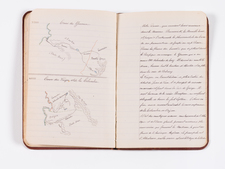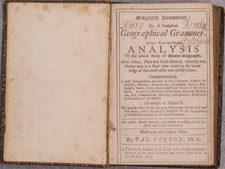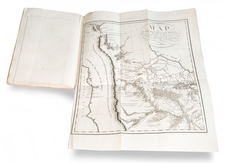"This is the most advanced Latin edition of the Theatrum published by Vrients." - Koeman (Ort 36)
[A6, including engraved title page], [B6], [C6], [D4], and 118 double-page engraved maps all of which with Latin text on verso. This copy is complete through the Theatrum but is bound without the Parergon or the Nomenclator Ptolemaicus.
Koeman says of this edition:
This is the most advanced Latin edition of the Theatrum published by Vrients. According to the colophon of the Nomenclator this edition was printed by Robertus Bruneau. A number of new maps was added by Vrients. Some of them may have appeared earlier in the 1602 Spanish edition.
The new maps added by Vrients in 1602/03 include the following:
Van Den Broecke No. 20: Anglia Regnum si quod aliud in toto Oceano ditissimum et florentissimum. Christophorus Saxton describebat 1579. (England after Saxton. In this edition it is map 12.)
Van Den Broecke No. 57: Deutschlandt. Germaniae typus. Per Franc. Hogenbergium concinnatus Anno CD.D.LXXVI. D. Constantino a Lijskirchen... (Germany after Hogenberg. In this edition it is map 36.)
Ortelius's Theatrum Orbis Terrarum (or "Theater of the World") is widely considered to be the first modern atlas, meaning that this was the first published set of uniform maps with supporting text gathered in book form. Previous bound map collections exist, for example the Italian Lafreri atlases, but these were sets of maps selected and bound together on demand. The Theatrum, in contrast, was the best available summary of sixteenth-century cartographic knowledge, covering much of the exploration of the world in the century following the discovery of America.
The atlas was first published in 1570 in Antwerp. Ortelius’ atlas outperformed later competing atlases from other cartographic luminaries like the De Jode and the Mercator families. The broad appeal of the work is demonstrated by the array of languages in which the atlas appeared: in addition to Latin, the atlas was published with text in Dutch, French, German, Italian, Spanish, and English. Between 1570 and 1612, at least 31 editions of the atlas were published in seven languages. The editions grew over time, with the first edition having 70 maps on 53 sheets, and the 1612 edition having 167.
At the time of its publication, the Theatrum was the most expensive book ever produced. Ortelius created all the maps personally, hand drawing the rough sketches. Those drawings were then interpreted into prints by his engravers Frans Hogenberg, Ambrosius Arsenius, and Ferdinand Arsenius.
After Ortelius's death in 1598, the copper plates for his atlas passed to his heirs. They, in turn, sold the collection to Jan Baptist Vrients (1522-1612) in 1601. Vrients added new maps and published the atlas until his own death in 1612. Vrients's widow then sold the plates to the Moretus brothers, who were the successors of Christoffel Plantin. Recent research has unearthed examples of the atlas with maps dated to 1640.
Abraham Ortelius is perhaps the best known and most frequently collected of all sixteenth-century mapmakers. Ortelius started his career as a map colorist. In 1547 he entered the Antwerp guild of St Luke as afsetter van Karten. His early career was as a business man, and most of his journeys before 1560, were for commercial purposes. In 1560, while traveling with Gerard Mercator to Trier, Lorraine, and Poitiers, he seems to have been attracted, largely by Mercator’s influence, towards a career as a scientific geographer. From that point forward, he devoted himself to the compilation of his Theatrum Orbis Terrarum (Theatre of the World), which would become the first modern atlas.
In 1564 he completed his “mappemonde", an eight-sheet map of the world. The only extant copy of this great map is in the library of the University of Basel. Ortelius also published a map of Egypt in 1565, a plan of Brittenburg Castle on the coast of the Netherlands, and a map of Asia, prior to 1570.
On May 20, 1570, Ortelius’ Theatrum Orbis Terrarum first appeared in an edition of 70 maps. By the time of his death in 1598, a total of 25 editions were published including editions in Latin, Italian, German, French, and Dutch. Later editions would also be issued in Spanish and English by Ortelius’ successors, Vrients and Plantin, the former adding a number of maps to the atlas, the final edition of which was issued in 1612. Most of the maps in Ortelius' Theatrum were drawn from the works of a number of other mapmakers from around the world; a list of 87 authors is given by Ortelius himself
In 1573, Ortelius published seventeen supplementary maps under the title of Additamentum Theatri Orbis Terrarum. In 1575 he was appointed geographer to the king of Spain, Philip II, on the recommendation of Arias Montanus, who vouched for his orthodoxy (his family, as early as 1535, had fallen under suspicion of Protestantism). In 1578 he laid the basis of a critical treatment of ancient geography with his Synonymia geographica (issued by the Plantin press at Antwerp and republished as Thesaurus geographicus in 1596). In 1584 he issued his Nomenclator Ptolemaicus, a Parergon (a series of maps illustrating ancient history, sacred and secular). Late in life, he also aided Welser in his edition of the Peutinger Table (1598).

![Theatrum Orbis Terrarum [with:] Parergon, Sive Veteris Geographiae Aliquot Tabulae [and:] Nomenclator By Abraham Ortelius / Johannes Baptista Vrients](https://storage.googleapis.com/raremaps/img/small/92703.jpg)










![[ Colorado Atlas -- Presentation Copy ] Geological and Geographical Atlas of Colorado and Portions of Adjacent Territory](https://storage.googleapis.com/raremaps/img/small/101702.jpg)

![(Ecclesiastical Atlas) Chorographica Descriptio Provinciarum et Conventuum Fratrum Minorum Francisci Capucinorum [Chorographic Description of the Provinces and Convents of the Friars Minor of Francis Capuchin. . . ]](https://storage.googleapis.com/raremaps/img/small/93059.jpg)


![[Composite Atlas of the World]](https://storage.googleapis.com/raremaps/img/small/99938.jpg)